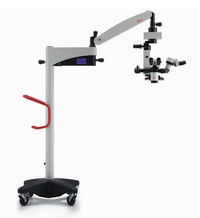Jul 21 2007
Although modern medical technology has reduced the time it takes to perform ophthalmic surgery, the workload has steadily increased as more operations are performed per day with less time between cases.
To meet the needs of the busy surgical suite, Leica Microsystems has designed the Leica M620 F18, which combines easy set-up and control with high-quality optics, precise illumination, a compact, durable design, at a better price/performance ratio than ever before.
Using Leica's high-precision OptiChrome™ optics and new Direct Halogen Illumination, the surgeon sees a clear, sharply-focused image throughout the entire operation. The sterile jalousie device allows the surgeon to adjust illumination and contrast to the unique physical characteristics of the patient, such as extreme eye pigmentation. The result is completely stable Red Reflex and exceptional intensity.
The logically designed touchscreen is integrated with the stand and clearly displays all settings at a glance to allow fast and easy operation of all microscope controls. User profiles can be programmed for up to four surgeons. Each surgeon can recall his or her individual settings at the press of a button.  Leica M620 F18 Combines Precision With Compact Design and Easy Operation
Leica M620 F18 Combines Precision With Compact Design and Easy Operation
If the Leica M620 F18 is returned to the vertical home position after an operation, the start parameters automatically reset, and the microscope is immediately ready for the next patient. Leica's Auto Reset function saves valuable time and makes work easier for the entire surgical team.
Leica has designed the M620 F18 to minimize fatigue because doctors and medical staff spend long working hours at the microscope. Leica's ergonomic eyetube is designed specifically for cataract surgery and allows a viewing angle of 5 to 25°. If required, a co-viewing attachment can be added which rotates along three axes for flexible positioning to give an assistant room to maneuver, even in cramped working conditions.
The compact stand and high-quality rollers ensure smooth movement and easy maneuverability. With the long-reach swingarm, the Leica M620 F18 can easily be positioned in the operating room. Using a video adapter such as the Leica Video Zoom Adapter, any video system can be connected to the beamsplitter for documenting and archiving the images. Additional accessories, e.g., for observing the retina or laser filters, easily integrate with the system. Leica Microsystems offers a wide range of binocular tubes and objectives to offer a microscope configuration to fit every individual surgeon's needs.